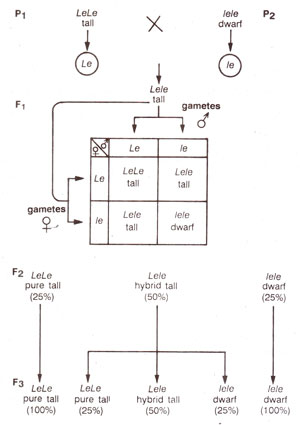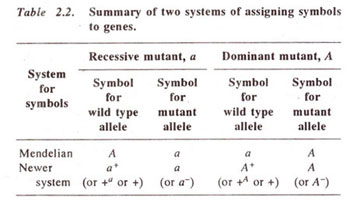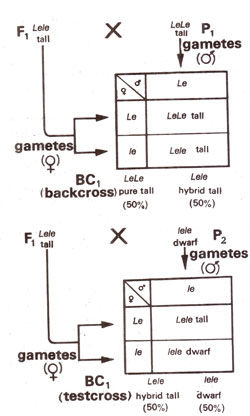Symbols and Terminology in Genetics

Fig. 2.3. Inheritance of stem length showing designations used to represent different genotypes in the parents, F1, F2 and F3 generations.
English alphabets were used by Mendel to represent the factors. A capital letter like ‘A’ signified dominant member and lower case like 'a' signified the recessive member. Since large number of genes are now available, one or more alphabets are chosen to indicate the characters for which they are used. The alphabet is chosen on the basis of the mutant character (mutant character is one which deviates from the wild type; wild type character is one which is most common). For instance, since garden pea is normally tall, the dwarf (affecting stem length) which is considered to be mutant, can be represented by letter ‘le’ (lower case in italics is used to indicate recessive nature). The tall will then automatically receive the designation 'Le' (capital italics showing dominance).

Fig. 2.3. Inheritance of stem length showing designations used to represent different genotypes in the parents, F1, F2 and F3 generations.
Terminology
The following terms are commonly used in genetics and should be understood :
Gene.
In modern sense an inherited factor that determines a biological character of an organism is called a gene. This is a functional unit of hereditary material. In the past, gene was believed to be unit of structure also, but recent knowledge has shown that it is no longer a unit of structure.
Alleles, the abbreviated form of the term 'allelomorphs' (meaning one form or the other) indicates alternative forms of the same gene. For instance, in the above example ‘Le’ and ‘le’ are two allelomorphs of the gene for plant height. In pure tall or pure dwarf plants, same allele is duplicated (Le Le or le le), while in hybrid tall, both the alleles will be present (Lele). An individual having only one allele or in other words two identical alleles, is known as homozygous (LeLe or lele). Similarly, an individual, having two different alleles will be called heterozygous or hybrid (Lele). In the present usage the term gene and the allele are interchangeable, but while gene can be used for any factor, allele is used with reference to another allele. For instance, while ‘Le’ and ‘le’ are alleles to each other, they cannot be allelic to any other gene.
Monohybrid, dihybrid and trihybrid.
In the examples discussed earlier in this section, single characters each controlled by a single pair of genes or alleles were considered. Such crosses are known as monohybrid crosses and the F2 ratio of 3 : 1 is known as the monohybrid ratio. Similarly crosses can be considered when two or three pairs of genes or alleles are involved. Such crosses will be called dihybrid and trihybrid crosses and the respective ratios as dihybrid and trihybrid ratios.
Reciprocal crosses.
A set of two reciprocal crosses means that the same two parents are used in two experiments in such a way that if in one experiment, 'A' is used as the female parent and 'B' is used as the male parent, in the other experiment 'A' will be used as the male parent and 'B' as the female parent.
The F1 individuals obtained in a cross are usually selfed to get the F2 progeny. They can also be crossed with one of the other two parents from which they were derived. Such a cross of F1individual with either of the two parents is known as a backcross. In such backcrosses, when F1 is backcrossed to the parent with dominant phenotype, no recessive individuals are obtained in the progeny. On the other hand, when it is crossed with recessive parent, both phenotypes appear in the progeny. While both these crosses are backcrosses only the cross with the recessive parent is known as a testcross. It is called a testcross, because it is used to test whether an individual is homozygous (pure) or heterozygous (hybrid).






